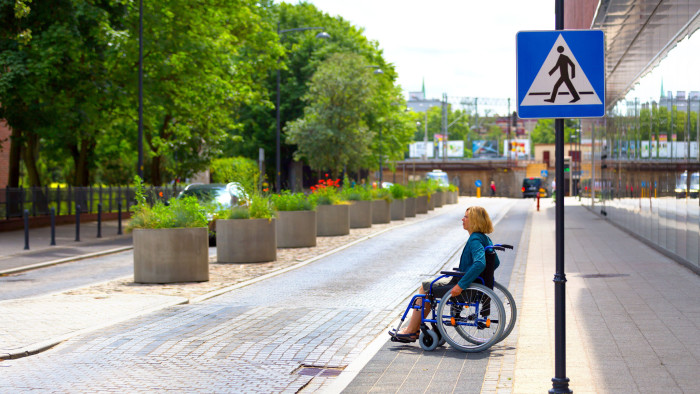Better data paves the way for improved accessibility

Roula Khalaf, Editor of the FT, selects her favourite stories in this weekly newsletter.
Data is the lifeblood of technology-driven smart cities, with both strategic urban planning and real-time city management relying on multiple data sources to make more informed decisions. However, experts say that this level of analysis is not necessarily making our cities more accessible and inclusive for people with disabilities.
“Cities do not know how accessible they actually are and how to improve,” says James Thurston, vice-president for global strategy and development at G3ict, a UN group.
In 2016, G3ict launched the Smart Cities 4 All initiative to highlight the problem. For its Inclusive Innovation Playbook project, 200 entrepreneurs were asked about the extent to which accessibility features in their design and development process. Some 43 per cent said they had a strong understanding, and a third were unsure if people with disabilities could use the technology products and solutions they were developing.
“We were seeing amazing new smart solutions and technology products being developed in incubators and deployed by cities — but without any real thought to how or whether they work for all people,” says Mr Thurston.
None of the innovations for smart cities — location-based digital services, Internet of Things sensors, new transport methods and data-driven automation — are inherently inaccessible for people with different mobility, sensory and communication needs. Nonetheless, they carry the potential to exclude people inadvertently if they are rolled out without considering accessibility.
New York City was sued in 2016 by the National Federation of the Blind after the city installed touchscreen kiosks that provided pedestrians with directions, WiFi and phone-charging capabilities, but did not include functionality for people with visual impairments.
Once such problems are brought to the attention of technology providers and city planners, they are often resolved quickly using technologies that are already pervasive in consumer products, such as text-to-speech capabilities. Mr Thurston says that all parties share an interest in promoting more inclusive technologies and services across cities, but oversights continue to happen due to a lack of awareness and poor uptake of technology accessibility standards.
Megan Lawrence, a senior accessibility technical evangelist at Microsoft, visited more than 70 cities last year to promote inclusion as a fundamental feature of smart cities. She found that the majority of city leaders understand that accessibility is integral to the success of their city and its long-term strategy, but few cities have a dedicated task force on accessible technology procurement.
“All cities can make accessibility a key part of the procurement language,” she says. “As they think about innovative new technologies, it has to be through a lens of inclusion.”
Ms Lawrence says cities such as New York and Chicago are right to appoint commissioners for people with disabilities. For cities to modernise in an inclusive way, she says, people with disabilities must hold positions of influence and be embedded in development projects.
Hidden opportunities to leverage data and technology to improve city accessibility are revealed when inclusion becomes a core aim. Accessibility challenges that, at first glance, appear to be manual or physical city management tasks can be met with digital solutions and data that are not obviously connected to people with disabilities.
One of the most urgent challenges — ensuring pavements are accessible for wheelchair users — is a prime candidate. Mr Thurston says it is the top point of contention from disabilities commissioners worldwide, hampering inclusion and economic outcomes for people with disabilities.
“While the problem is one of the built environment not the digital one, we are seeing innovative cities and companies use technology to tackle it,” he says.
As technology companies such as Google developed digital tools for navigating city life, people with disabilities crowdsourced information about accessibility, creating projects such as Project Sidewalk, AccessNow and AXS Map.
New York has engaged Dutch company Cyclomedia to improve accessibility, applying its imaging of physical spaces to create a detailed view of the city’s roads and pavements. Combining LIDAR 3D mapping technology and advances in artificial intelligence, Cyclomedia has provided data for the city to make urgent repairs to pavements and create an investment strategy for developing accessible streets in the long term.
“Humans have an incredible ability to crowdsource and share information that people with disabilities need to know,” says Ms Lawrence. “But now we have the opportunity to use high-resolution imagery, IoT sensors and streetscape databases created for autonomous vehicles. Technology could be a force multiplier to reduce the barriers for people with disabilities.”

Comments